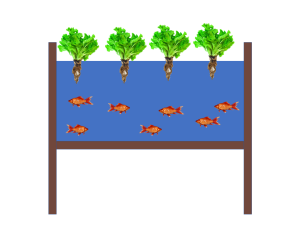What is Aquaponics?
Aquaponics is a food production system that gets a lot of attention in today’s world. Aquaponics is an exciting way to grow fish and plants at the same time. The fish waste is full of nutrients that feed the plants, and the plants filter the water for the fish. In the aquaculture part of the system, bacteria break down the waste from the fish and turn it into dissolved nutrients that plants can use to grow.
Aquaponics Advantages:
- Reduced land area requirements,
- Reduced water consumption,
- Accelerated plant growth rates,
- Year-round production in controlled environments,
- Operational efficiency with shared equipment,
- Reduced or eliminated effluents, and
- Multiple crops produced simultaneously.
Aquaculture System Components:
- Glass fish tank or plastic container
- Styrofoam sheet
- Plant growing net pots
- Air pump
- Perlite or coconut coir
- Fish food
FAQ
Q: What fish species are best for Aquaponics?
A: Tilapia, carp, catfish, goldfish, tetra, guppies
Q: What vegetables can you grow in aquaponics?
A: Lettuce, watercress, arugula, radish, herbs, tomato, spinach
Q: How many fish can I grow in an aquaponics system?
A: about 1 lb of fish per 5 -10 gallons of water, or 1-2 fish per 10 gallons of water.
Q: How many plants can I grow?
A: That depends on the type of plant you are growing, but in general you can plant about twice as densely in aquaponics as you can in a traditional soil-based garden.
Q: How much should I feed my fish?
A: Feed only the fish with what they can consume in 5 minutes and remove any uneaten fish food to avoid unwanted water quality issues.
For more information please EDIS publication: https://edis.ifas.ufl.edu/publication/HS1252
Source: UF/IFAS Pest Alert
Note: All images and contents are the property of UF/IFAS.




